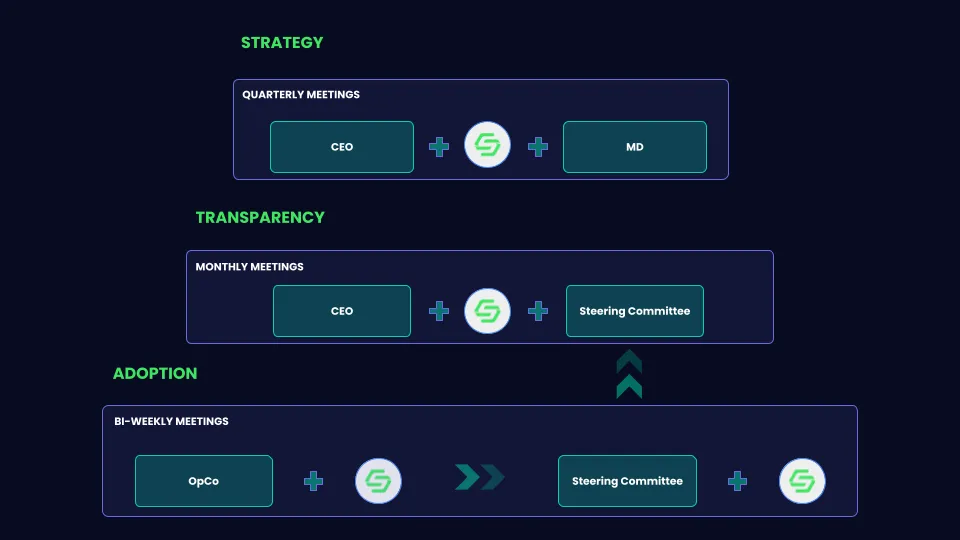In an increasingly innovative and competitive transport market, optimising network performance based on data insights is no longer a nice to have — it’s an essential part of delivering high performing bus services. For senior leaders in transport group operations, the challenge isn’t just implementing this data-driven approach but also driving the internal change necessary for its adoption and long-term success.
Let’s explore how accessing insights from historical network performance data can unlock a better passenger experience. We’ll dive into practical strategies for guiding your teams through this transition, ensuring your organisation not only harnesses historical data but fully realises its potential to maximise network performance.
Navigating organisational barriers to data-driven change
Transport groups operate with a layered structure, where OpCos manage day-to-day operations, and are overseen by those at Group level. This layered structure creates a gap between senior leadership and schedulers and results in the CEO’s strategic vision for the network having to filter down through multiple management tiers to reach the people who are responsible for making changes to the network.
The people in the levels between the CEO and Schedulers hold the majority of the control over how the network performs, however, gaps in visibility and trust in performance data can lead to challenges:
- Disconnected decision-making: Senior leadership need quick and easy access to accurate insights into on-the-road network performance, so they can identify network issues and decide the most appropriate way to resolve them.
- Data distrust: Network performance issues are often put down to on-the-road factors, but without solid data to back this reasoning up, effective and accurate decision-making is hindered.
- Industry knowledge gaps: Senior leadership come from a range of backgrounds, not just from the transport industry, and can sometimes face additional hurdles in understanding network performance, particularly when they don’t have easy access to reliable, relevant performance data.
To overcome these barriers, operators must move beyond traditional methods and embrace network performance data as a strategic asset for improving service reliability, efficiency, and customer satisfaction.

Taking a data-informed approach to network performance
By putting performance data at the heart of network optimisation, the gap between strategic decision-making and operational challenges can be bridged. Taking this approach enables transport groups to:
- Improve service reliability: Optimised scheduling that delivers optimal bus services that run on time, improving passenger experience and demand.
- Increase efficiency and revenue: Ticketing demand data helps identify the optimal timetable to maximise revenue.
- Reduce costs and invest in growth: According to CPT’s 2024 Cost Monitor, a 10% increase in bus speeds can drive a 2.5% rise in passenger demand while reducing operating costs by 8%, freeing funds for investment in more frequent services or zero-emission vehicles.
How to use network data to transform group performance
Successfully embedding data-driven decision making into optimising network performance requires transformational change. Senior leadership can drive adoption by focusing on three key areas - technology, process and growth.
Embrace technology
- Establish a group-wide AI and data strategy that encompasses technology, upskilling people, building a data culture, and implementing data management processes.
- Leverage technology for accurate insights by providing Group-wide access to optimisation and analytical tools.
- Combine data insights with local knowledge to identify and prioritise network enhancements.
- Use consistent data to standardise scheduling and network planning processes throughout the group.
Facilitate process
- Establish a clear communication plan to keep the teams aligned.
- Create a steering committee to champion adoption.
- Identify network performance KPIs.
- Embed into existing processes with forums to highlight successes and areas for improvement.
- Facilitate bi-weekly steering committee meetings to drive adoption.
- Run monthly performance reviews with the CEO to secure accountability and provide transparency.
- Hold quarterly MD and CEO meetings to track usage of the technology being used and rank performance against KPIs, ultimately ensuring the network performance strategy is achieved.
- Showcase wins through internal comms channels to continuously track and highlight success stories.

Drive growth
- Understand and resolve poor performance.
- Identify underserviced areas within the network that provide opportunities for growth.
- Use data-backed bidding analysis to protect and win new business.
- Support expansion into new markets with accurate data insights.
Leading the future of data-driven transport group operations
To remain competitive, transport groups must not only implement performance optimisation tools but also embrace the organisational change needed to ensure their successful adoption. By strategically leveraging data, embedding structured processes, and supporting teams with the right tools and training, transport operators can transform the performance of their network to deliver a better passenger experience.
Are you ready to take a data-driven approach to transforming transport group operations? Download our checklist for a step-by-step guide to get started today.





